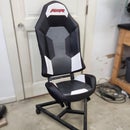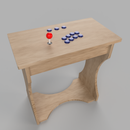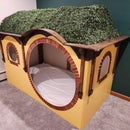Introduction: How to Make a Knife (Stock Removal Method)
I had been wanting to make a knife for one of my good friends who does civil war reenacting and now that he and his wife are expecting a baby girl I though he needed something to help scare away the boys. I designed this after what I have seen called frontier style knives because I felt like it fit that time period well but you can hopefully use this instructable to design any knife style or shape of your choosing.
I have been making knives as a hobby for a little while but just recently got involved with Instructables so I figured it would be a good to show my take on making knives.
Step 1: Determine the Shape of the Knife
For some of my knives I have templates that I already made but sometime I will just wing it if I'm making a new design. I used 1/8 in O1 tool steel because that is what I had on hand. I already had some rectangular blanks cut so I had to determine what size I wanted to use for this knife. I used a cardboard template to transfer the design onto the steel.
TIP: I cut out a piece of cardboard the same size as the blank to make a prototype to check how it felt in the hand. I've had knives that I thought would be good only to find out after I cut them to shape then the handle was too small. If you aren't constrained by your blank size then you don't have to start with a specific sized piece of cardboard like I did.
Step 2: Cut the Blank to Shape
Now that I had the shape determined, it was time to cut out the basic knife shape. I used a hacksaw while the blank was clamped in place to cut out the rough shape. I then cleaned up the shape on my 2 x 72 Belt Grinder I just made. This was the first knife I made since I upgraded from a 4 x 36 belt sander and I have to say it is a huge improvement.
TIP: Use what you have and are comfortable with. If you have an angel grinder then you could use that to cut out the rough shape. When cleaning up the shape, any belt sander with the right belts, bench grinder, or even using files will work.
Step 3: Hammer Finish (Optional)
For this knife, I wanted it to have that forged hammered look so I used a chunk of steel as an anvil and then hit it a ton with a ball pein hammer. (Sorry for the shaky video. I should have realized it was a bad idea to mount my phone on the same bench I was hammering on)
TIP: When you hammer the blade it will bend from the hitting. When you are near done you will want to make sure that it is back to flat. This will probably take alternating flipping and hitting on either side until it is finally flat.
Step 4: Initial Bevel
Now that the shape is where you want it, it is time to put the rough bevel on the blade. Before you will begin you will want to mark the center line. You can do this by marking the blade edge with a sharpie and then use a drill bit the same thickness as your blade to run align the edge to scratch in a center line. I couldn't get a good picture of this with my phone so unfortunate I cant show the line on the blade. Now that you have the center line you can proceed with grinding the bevel.
TIP: I ground this bevel free hand but there are many jigs that you can make if you want a consistent bevel or don't want to try free hand. I usually use a jig but I want to do more free hand to get better at it.
TIP 2: Do not grind the bevel too close to the center as it can warp during heat treat. You want a pennys thickness of material left before heat treat.
Step 5: Finalizing the Shape
So, I though I liked the shape but then I changed my mind. As long as you are removing material, you can always alter your design as you go along.
TIP: If you use a Dremel like me for grinding to shape then I'd recommend getting those cheap lots of sanding drums rather than the Dremel brand ones. The off brand ones wont last as long but you will get considerably more. In the long run, it is a better price for the amount of grinding you will do.
Step 6: Making the Handle Scales
Now that the knife is shaped it is time to make the scales that will be the handles. I made these scales out of walnut because I wanted to use an American wood because I figured that is what would have been available back in mid 1800's. I cut the piece in half to make two matching scales. Once they were made I then drilled the holes in the blade and then used those holes as guides to drill the holes in one of the scales. I used two other drill bits to keep the two pieces aligned. I then used one scale as the template for the holes in the second one.
TIP: If you do not have the resources to make your own scales then you can always buy them from any knife making site or even eBay.
Step 7: Profile the Handle
With the scales made and drilled it was now time to profile them to match the shape of the knife.
TIP: Many people only shape the front end of the scales until they are assembled onto the knife but I did it this way because I planned on etching the blade and did not want to remove the etch coloring when shaping the handles. Doing it this way can be more difficult but I needed to do it to achieve the look I was going for.
To shape these I first added two pins through all three parts to keep them aligned and then roughed out the shape leaving a small gap before I reached the metal. I then switched to a lower grit belt and finished shaping it down to the metal. I also used my Dremel to reach the small radius that my belt grinder could not. I then sanded it down to 300 grit as once they are removed from the blade I can not sand those edges or it would end up being smaller then the blade underneath.
Step 8: Shape and Finish the Handle
Now that the outside shape was made it was time to finalize the handle shape. I sanded both scales down to the thickness that I wanted and then used two smaller pins to hold them together to shape the front. Then all that was left was to hand sand them down to the desired shape and apply your desired finish.
TIP: I applied the finish to the handles before gluing them to the blade because when gluing handles to the blade there is often epoxy that will get onto the handles and prevent whatever finish you use from applying to that part of the handle. I had this happen once and it left me with a discolored section of the handle where the epoxy still was. You don't need to do this if you wait to shape the handle until after you attach it to the blade.
Step 9: Heat Treat and Temper
Now it's time to harden the blade. I used a small forge I built when I started making knives. It doesn't retain heat well because it is too large for the heat source but I can still get a good heat treat with it. Then it's off to the oven for tempering.
TIP: For O1 tool steel you will want to heat up the blade until it is not magnetic (~1500 degrees F), just check it with a magnet until it no longer is attracted to the steel, and you will want to let it soak at that temperature for about 15 minutes. I've never timed it but make it close. I quench mine in plain old canola oil that has been heated to around 125 degrees. Then for the temper (this makes it so it isn't as brittle), I would recommend 2 sets of 2 hours at 400 degrees letting it completely cool between sets. If the heat treat is good then a file will glide across the blade without biting into the material.
Step 10: O1 Tool Steel Blade Testing
I'm including this step in here for anyone who would like to know more about how well O1 steel holds up as a blade. The first knife a made had two small of a handle so I decided it would make a good test knife to see just how good my heat treat was and how good the steel was. I know my heat treat isn't the most precise so even if yours isn't either you can expect similar results.
TESTS:
- Hardness: I got around 59-60 HRC for the blade. Due to this being my first heat treat, the tip didn't get a hard as it should have.
- Tip retention: I had a 2 x 2 that I jammed the tip into and then continually pried it out. The tip was not damaged.
- Chop test: I chapped my way through an entire 2 x 2. Cutting paper showed it was close to if not just as sharp as before testing.
- Baton test: I hammered it though a couple dried logs and then hammered it though a 2 x 2 against the grain. Blade did not crack and I hit it hard to get it through.
- Nail and Bolt Cut: I knew this would damage the blade but was curious how much. Cut though a nail not problem but did damage the blade. Cut about half way through a small bolt but did a good amount of damage to the blade.
- Bend test: I needed to find a way to break this so I figured bending it would do the trick. The handle finally bent and then after I could get more leverage on it I got the blade to snap. If the handle bends that much before the blade breaks then you're not using the knife right.
Overall I was happy with the results of this test as it showed it could take a lot of abuse and hold up well. Hope this is helpful to anyone using O1 steel for knives.
Step 11: Finalize the Bevels
Now that it is heat treated, it was time to grind it down to the the thickness you want.
TIP: If you don't grind it down far enough then it just means you will have to do more sharpening. And let me tell you, it can mean the difference of a 1 hour sharpening job to a 3-4 hour sharpening job.
Step 12: Etch the Blade (Optional)
I wanted the blade to be a dark gray color so I etched it in ferric chloride. I used nail polish to protect the edge of the blade while it was being etched. I then cleaned it off with acetone to remove any grease from my hand or anything that would effect the etch. Then add the ferric chloride and water to a plastic or glass container and wait for it to etch. After it was removed from the etch, I scrubbed it with some 0000 steel wool to clean off any residue and then ground the bevels again to expose the shiny steel again. I wanted the contrasting color of a dark blade with a shiny bevel.
TIP: You will want to dilute the ferric chloride before using it and I would recommend checking it every 5 to 10 minutes until it reaches the darkness you desire. I used a 1 part ferric chloride to 2 parts water mix. If you use hot water it can speed up the etch. If you clean it off and it isn't as dark as you want then put it back in again, it can build up scale which will slow the etch.
Step 13: Glue It Together
It is now ready to be assembled. I used T-88 epoxy for this and then glued the handles to the blade with the pins in place. I used 1/8 in 360 brass for my pins.
TIP: It helps to make cavities between the handle and blade for the epoxy to fill. I used a Dremmel and scored some X's into the blade but you could also drill some additional holes that would make room for the epoxy.
Step 14: Smoothing Down the Pins
Now that it is all glued up it is time to trim the pins down. I used a hacksaw to cut the pin down closer to the handle and then used the belt grinder to sand them down until they just barely stuck out. I would usually sand them down all the way but because of the look I was going for I decided to use my ball pein hammer and hammer them the rest of the way flat. This resulted in a hammered pin look which gives it that older style look.
TIP: You can use nicer looking mosaic pins but you can not hammer these. They will have to be ground flat if you use them.
Step 15: Making the Leather Handle Wrap (Optional)
One of the things that I saw on knives of this style was a small piece of leather that wrapped around the front of the handle where your index finger would rest. I thought this looked cool and had the leather so I figured why not add it. I used some 4-4.5 oz leather that I had. If you are buying leather for this I might recommend getting something a little bit thinner than that but it ended up working fine. I cut it to the width I wanted then then taped it in place so that I could mark where to cut. After cutting it was then just time to stitch it up. I chose to do a x patter but you could do whatever you want.
TIP: When marking where to cut you want to make sure to leave a gap so that when you stick it up it will be pulled tight and will not move up or down the handle. Use a big needle to stitch this and I have found it works best to pre-puncture your holes before you start. When done with the stitch I would recommend putting a drop of super glue on the knot so that it will not come undone.
Step 16: Sharpening
All that is left to finish the knife is sharpen it. I used the Lansky sharpening system. I don't know how it compares to others out there but it was pretty cheap and it gets my knives shaving sharp.
Step 17: Make the Sheath (Optional)
Because I am sending this to a friend and really want to finish the complete look of the knife I decided to make a sheath for the knife. I used some thicker leather that I had. I believe this was 5 to 6 oz thick, the label didn't say. To make this you will want to fold the leather over your knife however you want it and then trace the edge of the knife making sure to leave a small gap from where you plan on cutting. This leaves room for the stitching. I used a leather punch to make the holes for this as the leather was thicker and then I stitched it up. I didn't take many pictures of the stitch pattern but because one of you requested it I added another step where I redid the stitch to better show how I did it.
Step 18: Sheath Stitch
Due to a request, I used a scrap piece of leather to show how I did this stitch. I just made an alternative X pattern and then I went back up going in and out the sides to pull it all together.
Step 19: Enjoy Your Knife
Your knife is now complete. All that is left is to go and enjoy the knife that you got to make. Just make sure that if you are not using a stainless steel that you will need to keep it from rusting. I use Burts Bees lip balm because I already had it and its a natural bees wax that is food safe wile providing a barrier to keep out moisture. A lot of waxes and oils work great for protecting the blade and don't leave it in a high moisture environment if you can help it.
TIP: If you plan on using your knife for any food purpose you should make sure any wax or oil you put on it is safe to ingest




